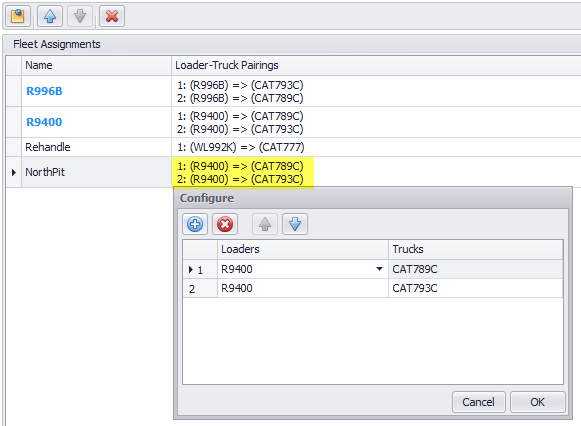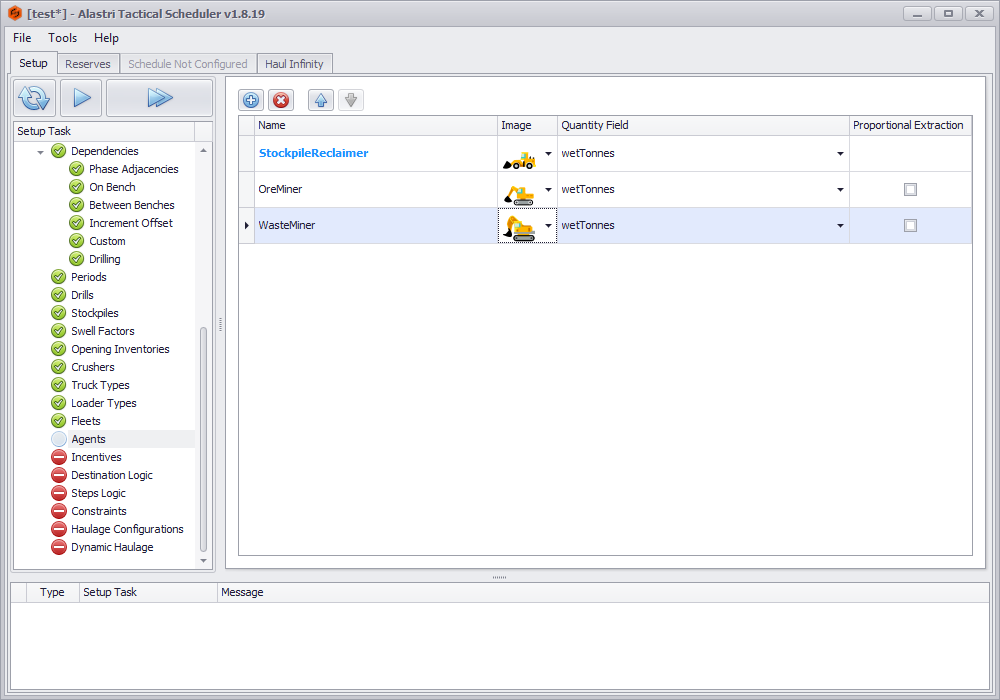ATS Loaders, Fleets & Agents
To understand the relationship between Loaders, Fleets and Agents, see ATS Schedule Logic Overview.
Review the setup steps for Loaders, Fleets and Agents.
Loaders
A Loader is a tool that expends hours to deplete blocks. When, where, and how much it digs is determined by the Agent targets and Fleet assignments.
- Agents select blocks for movement.
- Movements trigger Fleets.
- Fleets assign Loaders.
Once a Loader has been assigned to a movement, then its hours are depleted at the dig rate for the specified truck and material.
Some users may wish to exclusively link one Agent with one Loader (for reasons discussed in ATS Schedule Logic Overview). This can be done by ticking the "Use as Agent" option in the loader definition.
Production loaders ticked as Agent
If ticked, the Loader as Agent option automatically adds a (bold, blue) linked Fleet and linked Agent to the project.
Loader as Agent
The rationale behind ticking a Loader as Agent is to be able to specify a target in terms of numbers of loaders, rather than quantities of tonnes.
AgentTarget = NumUnits * (AgentRate * LoaderHours)
When we specify a target tonnes for a loader type, and when that loader has a fixed number of hours, then we are implicitly defining a tonnes per hour average rate over the period. This is the Agent Rate. Whereas the Loader Rate may fluctuate during the period depending on truck and material loaded, the Agent Rate is the fixed averaged movement of target tonnes over loader time.
As a rule, the Agent Rate should be approximately equal to the average Loader Rate, so that the target for one assigned loader is equal to the capacity of that loader. Misaligned targets to capacity may result in idle time or Overflow.
When using a Loader as Agent, the Enforced Matched Rates option overrides the Loader Rate with the Agent Rate (the Calendar overrides Haul Infinity in this case).
A Loader as Agent in Optimised Products mode may return Overflow if the Agent Rate > Loader Rate, since "1x loader target" is higher than "1x loader capacity".
Fleets
Fleets provide a means to switch between different truck-and-loader groups for given times, locations, materials and destinations.
Common examples:
- Production and Rehandle fleet
- Autonomous and Operator fleet
- Ore and Waste fleet
- North and South fleet
- Heavy and Light fleet
Fleets can be added by clicking the clipboard icon in the Fleets step and configuring the Loader-Truck pairings.
Fleets exhaust equipment in the order that they are listed.
Fleets are triggered by Agents via the Steps Logic.
Agents
An Agent picks a sequence of blocks for mining. It reads the dependencies to get available blocks, ranks them by the user-specified incentives, then picks the highest ranked block.
Multiple agents may be used if different block-picking or block-handling behaviours are required:
- Single Agent (Miner)
- Agents with concurrent incentives (OreMiner, WasteMiner)
- Agents with concurrent fleets in same pit (AHS, Operator)
- Agents with concurrent destinations for same material (Crusher1Agent, Crusher2Agent)
Agents pick blocks during scheduling.
Agents pick blocks during a period until stopped by Dependencies or Constraints.


